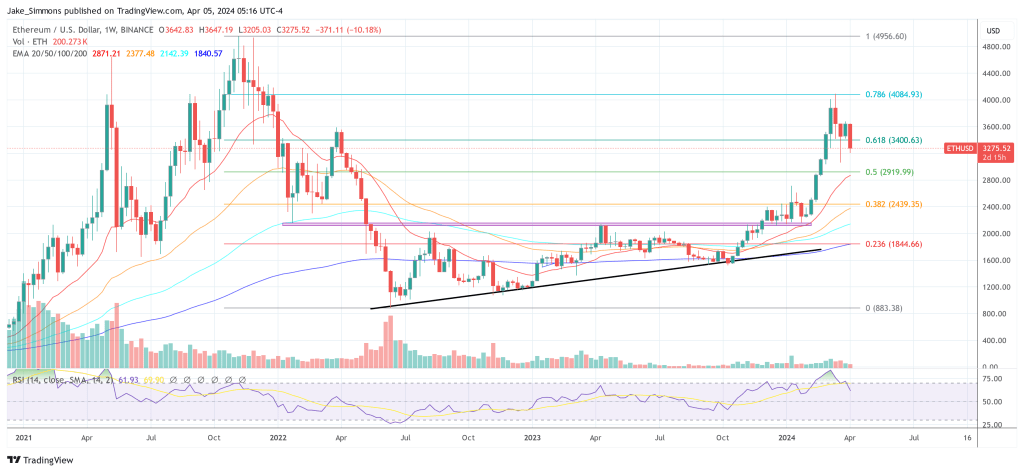In a comprehensive analysis, JP Morgan’s Global Markets Strategy team has delved into crucial developments occurring within the Ethereum network, shedding light on factors that could notably impact its classification under securities law. This report arrives at a pivotal moment for Ethereum (ETH), as the Swiss-based foundation faces scrutiny from the US Securities and Exchange Commission (SEC).
Exploring the Factors Behind Ethereum’s Non-Security Status
In a comprehensive analysis, JP Morgan underscores a noteworthy trend: the declining proportion of staked Ethereum (ETH) held by Lido, which has dwindled from approximately one-third a year ago to about a quarter presently. This observed shift signals a move towards a more decentralized staking ecosystem within the Ethereum network. Such a development carries significant implications, particularly in addressing regulatory apprehensions surrounding centralization within the Ethereum ecosystem.
JP Morgan’s report accentuates the positive trajectory for the Ethereum network stemming from this trend. With the share of staked ETH held by Lido diminishing further from its previous dominance, currently accounting for only around a quarter, concerns about concentration within the Ethereum network are mitigated. Consequently, this reduction in concentration levels augurs well for Ethereum’s regulatory outlook, potentially bolstering its prospects of sidestepping classification as a security in the future.
The report underscores the importance of this decentralization trend, suggesting that it could play a pivotal role in shaping Ethereum’s regulatory standing. By diversifying the distribution of staked ETH away from a single dominant entity like Lido, the Ethereum network demonstrates a greater resilience against centralization concerns, thus enhancing its regulatory compliance posture. This shift aligns with broader efforts within the cryptocurrency ecosystem to promote decentralization and mitigate regulatory risks, positioning Ethereum favorably within the evolving regulatory landscape.
The analysts also make mention of the “Hinman documents,” unveiled in June last year, which have been instrumental in shaping the SEC’s perspective on digital tokens. These documents underscore the significance of network decentralization, suggesting that tokens operating on a network with adequate decentralization may not be deemed securities.
The passage stated:
In particular SEC officials had acknowledged in the past that tokens on a sufficiently decentralized network are no longer securities because there is no “controlling group” in the Howey test.
Insights from the Community Regarding Decentralization
The response from the Ethereum community to these recent shifts has been notably optimistic. Anthony Sassano, renowned as the founder of The Daily Gwei and co-founder of EthHub, offered his insights on the decreasing dominance of Lido. He attributed this decline to the heightened competition within the staking sphere, viewing it as a positive development indicative of a more decentralized and robust ETH staking ecosystem.
Sassano’s perspective underscores a long-standing belief that fostering competition in the staking landscape is key to curbing Lido’s growth and reducing its market share. With increased competition now evident, he contends that the Ethereum staking ecosystem is experiencing a newfound vitality. According to Sassano, this shift signals a positive trajectory towards greater decentralization and resilience within the Ethereum network’s staking dynamics.
However, there is a divergence of opinions regarding the effectiveness of the current array of restaking projects. Some users have raised questions about whether these projects represent an improvement. Anthony Sassano countered this skepticism by emphasizing the need for a diverse ecosystem of Ethereum staking projects. He argued, “The debate can only take place once we have a thriving free market of Ethereum staking projects—not just a few dominant ones monopolizing the market share.”
Seraphim, who serves as the head of growth at Ethena Labs, offered a pragmatic perspective on the matter. He proposed that rather than engaging in criticism, focusing on offering superior yields proves to be a more successful strategy. Seraphim remarked, “It turns out that providing higher yields is a more effective business strategy than complaining, akin to the approach taken by Rocketpool trolls. I’m happy for LRT projects, even though I have a bias towards Lido. This advancement propels the sector towards new and exciting possibilities.”
Further Advantages for Ethereum
In their analysis, JP Morgan also emphasized the importance of the Dencun upgrade, a substantial technological leap forward compared to the previous Shanghai upgrade. This upgrade brings about significant improvements by introducing blobs and cryptographic schemes like the KZG commitment scheme, effectively reducing transaction costs on Ethereum layer 2, as noted in the report.
Looking into the future, the upcoming Petra upgrade is anticipated to bring further advancements, particularly through the implementation of Verkle trees. These trees are expected to enhance data storage efficiency, thereby contributing to Ethereum’s scalability and overall effectiveness. The report expresses optimism about Petra, highlighting its potential to simplify block verification by pruning historical blocks older than one year, ultimately conserving storage space and bandwidth.
As of the latest update, Ethereum (ETH) is trading at $3,275.

ETH needs to reclaim the 0.618 Fib, 1-week chart | Source: ETHUSD on TradingView.com
Read more on: JPMorgan expresses worry as the circulation of Tether’s USDT approaches $100 billion.



